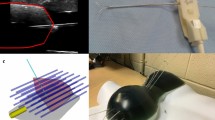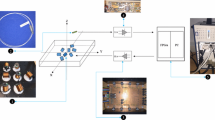Abstract
Purpose
Electromagnetic (EM) catheter tracking has recently been introduced in order to enable prompt and uncomplicated reconstruction of catheter paths in various clinical interventions. However, EM tracking is prone to measurement errors which can compromise the outcome of the procedure. Minimizing catheter tracking errors is therefore paramount to improve the path reconstruction accuracy.
Methods
An extended Kalman filter (EKF) was employed to combine the nonlinear kinematic model of an EM sensor inside the catheter, with both its position and orientation measurements. The formulation of the kinematic model was based on the nonholonomic motion constraints of the EM sensor inside the catheter. Experimental verification was carried out in a clinical HDR suite. Ten catheters were inserted with mean curvatures varying from 0 to \(6.6~\hbox {m}^{-1}\) in a phantom. A miniaturized Ascension (Burlington, Vermont, USA) trakSTAR EM sensor (model 55) was threaded within each catheter at various speeds ranging from 7.4 to \(32.1~\hbox {mm}\,\hbox {s}^{-1}\). The nonholonomic EKF was applied on the tracking data in order to statistically improve the EM tracking accuracy. A sample reconstruction error was defined at each point as the Euclidean distance between the estimated EM measurement and its corresponding ground truth. A path reconstruction accuracy was defined as the root mean square of the sample reconstruction errors, while the path reconstruction precision was defined as the standard deviation of these sample reconstruction errors. The impacts of sensor velocity and path curvature on the nonholonomic EKF method were determined. Finally, the nonholonomic EKF catheter path reconstructions were compared with the reconstructions provided by the manufacturer’s filters under default settings, namely the AC wide notch and the DC adaptive filter.
Results
With a path reconstruction accuracy of 1.9 mm, the nonholonomic EKF surpassed the performance of the manufacturer’s filters (2.4 mm) by 21% and the raw EM measurements (3.5 mm) by 46%. Similarly, with a path reconstruction precision of 0.8 mm, the nonholonomic EKF surpassed the performance of the manufacturer’s filters (1.0 mm) by 20% and the raw EM measurements (1.7 mm) by 53%. Path reconstruction accuracies did not follow an apparent trend when varying the path curvature and sensor velocity; instead, reconstruction accuracies were predominantly impacted by the position of the EM field transmitter (\( p\le 0.01\)).
Conclusion
The advanced nonholonomic EKF is effective in reducing EM measurement errors when reconstructing catheter paths, is robust to path curvature and sensor speed, and runs in real time. Our approach is promising for a plurality of clinical procedures requiring catheter reconstructions, such as cardiovascular interventions, pulmonary applications (Bender et al. in medical image computing and computer-assisted intervention—MICCAI 99. Springer, Berlin, pp 981–989, 1999), and brachytherapy.






Similar content being viewed by others
Notes
The path curvature \(\kappa _p\) at each point p with coordinates x, y, z was defined as:
\(\kappa _p=\frac{\sqrt{(z''\cdot y'-y''\cdot z')^2+(x''\cdot z'-z''\cdot x')^2+(y''\cdot x'-x''\cdot y')^2}}{(x'^2 +y'^2+ z'^2)^{3/2}}\) where each prime denotes the gradient.
References
Bender H-J, Männer R, Poliwoda C, Roth S, Walz M (1999) Reconstruction of 3d catheter paths from 2d x-ray projections. In: Medical image computing and computer-assisted intervention—MICCAI 99, vol 1679. Springer, Berlin, pp 981–989
Bharat S, Kung C, Dehghan E, Ravi A, Venugopal N, Bonillas A, Stanton D, Kruecker J (2014) Electromagnetic tracking for catheter reconstruction in ultrasound-guided high-dose-rate brachytherapy of the prostate. Brachytherapy 13(6):640–650
Whitaker M, Hruby G, Lovett A, Patanjali N (2011) Prostate hdr brachytherapy catheter displacement between planning and treatment delivery. Radiother Oncol 101(3):490–494
Simnor T, Li S, Lowe G, Ostler P, Bryant L, Chapman C, Inchley D, Hoskin PJ (2009) Justification for inter-fraction correction of catheter movement in fractionated high dose-rate brachytherapy treatment of prostate cancer. Radiother Oncol 93(2):253–258
Bø LE, Leira HO, Tangen GA, Hofstad EF, Amundsen T, Langø T (2012) Accuracy of electromagnetic tracking with a prototype field generator in an interventional or setting. Med Phys 39(1):399–406
Feuerstein M, Reichl T, Vogel J, Traub J, Navab N (2009) Magneto-optical tracking of flexible laparoscopic ultrasound: model-based online detection and correction of magnetic tracking errors. IEEE Trans Med Imaging 28(6):951–967
May 2016. [Online]. www.sjm.com//media/pro/therapies/mediguide/8350-mediguide-1114-0022-brochure-r3final
Zhou J, Sebastian E, Mangona D, and Yan V (2013) Real-time catheter tracking for high-dose-rate prostate brachytherapy using an electromagnetic 3d-guidance device: a preliminary performance study. Med Phys 40(2):021716
Nicolae AM, Bharat S, Kung C, Venugopal N, Dehghan E, Bonillas A, Stanton D, Kruecker J, Ravi A (2014) Electromagnetic catheter digitization in prostate high-dose-rate brachytherapy treatment planning. Brachytherapy 13:S41
Mehrtash A, Damato A, Pernelle G, Barber L, Farhat N, Viswanathan A, Cormack R, Kapur T (2014) Em-navigated catheter placement for gynecologic brachytherapy: an accuracy study. In: Proceedings of SPIE 9036, Medical imaging 2014: image-guided procedures, robotic interventions, and modeling, 90361F. doi:10.1117/12.2044381
Condino S, Calabrò EM, Alberti A, Parrini S, Cioni R, Berchiolli RN, Gesi M, Ferrari V, Ferrari M (2014) Simultaneous tracking of catheters and guidewires: comparison to standard fluoroscopic guidance for arterial cannulation. Eur J Vasc Endovasc 47(1):53–60
Damato AL, Viswanathan AN, Don SM, Hansen JL, Cormack RA (2014) A system to use electromagnetic tracking for the quality assurance of brachytherapy catheter digitization. Med Phys 41(10):101702
Poulin E, Racine E, Binnekamp D, Beaulieu L (2015) Fast, automatic, and accurate catheter reconstruction in hdr brachytherapy using an electromagnetic 3d tracking system. Med Phys 42(3):1227–1232
Kindratenko V (2000) A survey of electromagnetic position tracker calibration techniques. Virtual Real 5(3):169–182
Lugez E, Sadjadi H, Pichora DR, Ellis RE, Akl SG, Fichtinger G (2015) Electromagnetic tracking in surgical and interventional environments: usability study. Int J Comput Assist Radiol Surg 10(3):253–262
LaScalza S, Arico J, Hughes R (2003) Effect of metal and sampling rate on accuracy of flock of birds electromagnetic tracking system. J Biomech 36:141–144
Wilson E, Yaniv Z, Zhang H, Nafis C, Shen E, Shechter G, Wiles AD, Peters T, Lindisch D, Cleary K (2007) A hardware and software protocol for the evaluation of electromagnetic tracker accuracy in the clinical environment: a multi center study. In: Proceedings of SPIE 6509, Medical imaging 2007: visualization and image-guided procedures, 65092T. doi:10.1117/12.712701
Ascension Technology Corporation. 3D Guidance trakSTAR 2, Installation and Operation Guide
Lugez E, Sadjadi H, Akl SG, Fichtinger G (2015) Nonholonomic catheter path reconstruction using electromagnetic tracking. In: Proceedings of SPIE 9415, Medical imaging 2015: image-guided procedures, Robotic interventions, and modeling, 94150L. doi:10.1117/12.2081561
Welch G, Bishop G (2006) An introduction to the kalman filter. University of North Carolina, Chapel Hill
Bloch AM, Marsden JE, Zenkov DV (2005) Nonholonomic dynamics. Notices AMS 52(3):320–329
Duindam V, Xu J, Alterovitz R, Sastry S, Goldberg K (2010) Three-dimensional motion planning algorithms for steerable needles using inverse kinematics. Int J Robot Research 29(7):789–800
Webster RJ, Kim JS, Cowan NJ, Chirikjian GS, Okamura AM (2006) Nonholonomic modeling of needle steering. Int J Robot Res 25(5–6):509–525
Van Den Berg J, Patil S, Alterovitz R, Abbeel P, Goldberg K (2011) Lqg-based planning, sensing, and control of steerable needles. In: Algorithmic foundations of robotics IX. Springer, Berlin, vol 68, pp 373–389
Patil S, Burgner J, Webster RJ, Alterovitz R (2014) Needle steering in 3-d via rapid replanning. IEEE Trans Robot 30(4):853–864
Arun KS, Huang TS, Blostein SD (1987) Least-squares fitting of two 3-d point sets. IEEE Trans Pattern Anal Mach Intell 5:698–700
Sadjadi H, Hashtrudi-Zaad K, Fichtinger G (2014) Needle deflection estimation: prostate brachytherapy phantom experiments. Int J Comput Assist Radiol Surg 9(6):921–929
Sadjadi Hossein, Hashtrudi-Zaad Keyvan, Fichtinger Gabor (2016) Simultaneous localization and calibration for electromagnetic tracking systems. Int J Med Robot Comput Assist Surg 12(2):189–198
Sadjadi Hossein, Hashtrudi-Zaad Keyvan, Fichtinger Gabor (2016) Simultaneous electromagnetic tracking and calibration for dynamic field distortion compensation. IEEE Trans Biomed Eng 63(8):1771–1781
Tiong A, Bydder S, Ebert M, Caswell N, Waterhouse D, Spry N, Camille P, Joseph D (2010) A small tolerance for catheter displacement in high-dose rate prostate brachytherapy is necessary and feasible. Int J Radiat Oncol Biol Phys 76(4):1066–1072
Hastenteufel M, Vetter M, Meinzer H-P, Wolf I (2006) Effect of 3d ultrasound probes on the accuracy of electromagnetic tracking systems. Ultrasound Med Biol 32(9):1359–1368
Lugez E, Pichora D, Akl S, Ellis R (2014) Intraoperative ct scanning impact on electromagnetic tracking performance. Int J CARS 9(Suppl 1):S107–S108
Author information
Authors and Affiliations
Corresponding author
Ethics declarations
Funding
This work was supported by the Natural Sciences and Engineering Research Council of Canada. Gabor Fichtinger was supported as Cancer Care Ontario Research Chair. Chandra Joshi was supported by the Ride for Dad Foundation, Kingston - Prostate Cancer Research Grant 2013.
Conflict of interest
Elodie Lugez, Hossein Sadjadi, Chandra P. Joshi, Selim G. Akl, and Gabor Fichtinger declare that they have no conflict of interest.
Ethical approval
This article does not contain any studies with human participants or animals performed by any of the authors.
Informed consent
This articles does not contain patient data.
Rights and permissions
About this article
Cite this article
Lugez, E., Sadjadi, H., Joshi, C.P. et al. Improved electromagnetic tracking for catheter path reconstruction with application in high-dose-rate brachytherapy. Int J CARS 12, 681–689 (2017). https://doi.org/10.1007/s11548-017-1534-4
Received:
Accepted:
Published:
Issue Date:
DOI: https://doi.org/10.1007/s11548-017-1534-4




